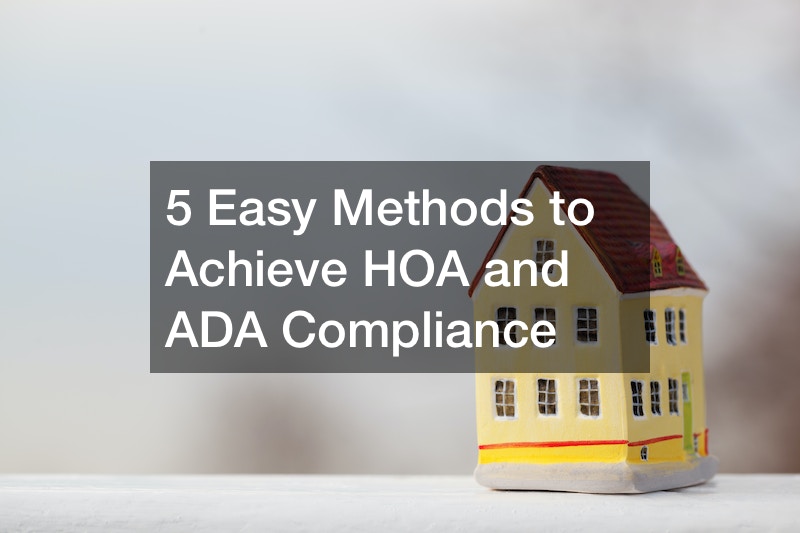
One of the most important aspects of owning a home is living in it without being discriminated against or facing other challenges. Homeowners associations (HOA) and the Americans with Disabilities Act (ADA) have initiated creating more equal living spaces for every person. These groups have addressed this issue by forcing developers and homeowners alike to adhere to specific codes meant to be ADA-compliant and HOA-compliant. The following outlines easy methods to achieve HOA and ADA compliance.
1. Evaluate Your Land

After purchasing a property, one of the first things to do is look at the existing structures around you. Know what’s out there. What houses, businesses, and different buildings are already in the area? The information will help you determine the structure needed for your home or business.
According to HOA guidelines, buildings can be anything from a single-family home to an office or apartment complex. These guidelines also classify them into different size categories.
Property survey plays a vital role in the HOA and ADA compliance process. A survey is an existing picture of a piece of land that provides essential information about the development. It outlines what types of structures exist in that area and where they are located.
Performing a survey before building helps identify potential restrictions or regulations that may prevent you from constructing a new structure on your property. The survey should also include information about each structure, size and shape, and much of the surrounding land.
The land clearing services pro can also inform you if any other requirements need to be addressed. For instance, if you find out an area is classified as a flood zone, you won’t want to build on top of it.
It would help if you also consider uploading your construction plans for ADA-compliant buildings and HOA compliance pre-approval with local authorities. The process is essential for getting feedback from different groups, such as the fire department or city planning officials, so your construction plans meet all required standards.
Making sure your house meets HOA and ADA compliance means you should include various items in your construction plans. The ADA-compliant design has to include ramps, railings along staircases, and other doors for wheelchairs.
There are a lot of gray areas when it comes to HOA and ADA compliance, but it’s essential to be aware of any limitations that may affect what you want to do with your property. For instance, an association may not allow building a second story on a home. The code might also prohibit construction on a certain side of the property. It’s also essential to research all the rules and restrictions in an area before building to ensure that you stay within them.
You don’t want to become a homeowner and start tearing down walls or changing your home design without knowing what’s allowed by HOA or ADA compliance guidelines. Hence, you should ensure not to break any of the regulations set by these groups.
2. Make Sure Your Yard Is Safe

Make sure your yard is safe for everyone. Cautiously considering the placement of your property’s driveway, deck, door, and driveway will help prevent falls and accidents.
If you’re planning on building a deck or a porch, make sure your structure is HOA and ADA-compliant to allow wheelchair access. When building an outdoor ramp, be sure it has handrails on both sides to prevent people from slipping off or tripping while they go down the ramp.
Before building a deck, you should check with your HOA or ADA compliance committee and receive their guidelines. A standard package of rules is required for the project, including the type of decking material used and whether it can be grass or paved. There will also be guidelines if you plan to build a swimming pool. The specifications can vary depending on the association’s requirements.
HOA and ADA-compliant porch, door, and front steps also add safety to your property. The best way to do this is by creating perimeter fencing around the area since people are more likely to fall off a stairwell if there is no railing surrounding it.
When doing a septic tank repair, you should make sure that your septic tank is properly installed. If you find out during the process that the tank is not properly installed or connected, you should contact an HOA compliance expert to get assistance in solving this. It’ll be helpful during the long septic tank installation period since it may take a long time and is expensive.
When building a fence, you should follow the HOA guidelines. The general rule is that the fence shouldn’t obstruct a neighboring property or block a neighbor’s view of the street.
Even though it might be tempting to cover your property with large plants and flowers, you shouldn’t do it. It may create problems with the HOA and lead to your not complying with ADA guidelines and construction blueprints.
If you plan to use soil from other regions, it’s best to ensure that you comply with all the regulations. The soil from other regions could have pests which would, in turn, spread in the neighborhood, causing plant damage. It’s advisable to consider local topsoil delivery because you would face minimal regulations. If you decide to use local soil, you must contact the environmental and safety department at the association for help.
3. Get Your Trees Trimmed

If you plan to have trees in your home, ensure the tree planting is HOA and ADA-compliant. You should also ensure that any trees on your property are trimmed correctly. Tree trimming is significant because it helps prevent branches from touching power lines or falling over fences. The ideal length for a tree is about six feet for front yard trees, six to eight feet for side yards, and eight feet for backyards. If you have multiple trees, you should get them to grow between two and four feet away from one another.
It might seem like an easy process when considering trimming your trees for HOA and ADA compliance. All you have to do is ask the expert to get started on tree trimming without having any concerns about your property not meeting HOA and ADA guidelines. It’s always a good idea to engage the help of a professional to ensure that everything is done correctly and within the guidelines set by the association.
Certified arborists are the people to engage when looking at HOA and ADA compliance guidelines because they better understand how these trees have been planted. They also have a better grasp of the rules set by associations due to their experience with different types of trees in different locations.
Before hiring a tree professional, you should ask them to provide you with references and ensure that they follow through on their work. If possible, get a few quotes from different companies to compare their services before choosing one.
Landscaping is one of the activities that make your home appealing. However, any landscaping activity should be in HOA and ADA compliance. For instance, some rules might prevent you from growing trees that grow into other people’s balconies or yards. Plants and flowers shouldn’t block any pathways. The design ensures no one trips over them when walking in the neighborhood.
Before hiring a landscaper, you should consider reading their portfolio to ensure they are qualified for the job. Also, you should find out whether they carry liability insurance and talk to some of their previous clients about their experience working with them.
4. Clean Off Each and Every Surface

It’s best to clean off any surface of your property that the public can see. The cleaning includes your lawn, bushes, mailbox, and driveway. HOA and ADA compliance guidelines state that you should maintain a clean property. Cleaning is important because it adds to the beauty of the neighborhood, and it will attract potential buyers if you plan on selling your home soon.
You can achieve better results by using pressure washers to remove dirt from surfaces instead of using a broom or a cloth to scrub them. For instance, roof pressure washing helps to remove dirt and grime that may have accumulated over the years. Pressure washing is also effective in removing rust and mold.
If you don’t have enough time to clean your environment, hire a power washing service to do the job for you. The service won’t just help you to achieve the ideal look, but it will also remove mold and debris that can be harmful to people living in the neighborhood.
Ensure that you have removed all peeling paint from your home because this indicates deterioration in your property. It can be a potential hazard to the home and people living there. Although it might be easy to ignore this issue, peeling paint can lead to extra costs if left unattended.
If you are looking at ensuring that your property is HOA and ADA-compliant, you should look for signs of home deterioration. Look for loose or chipping paint, cracks, and warped doors, windows, or fences. It pays to keep an eye out for issues like this because they could lead to bigger problems if left unattended over a long period.
It would help if you also took care of your sprinkler system, gutters, and HVAC systems. In addition, you should clear up any fallen leaves or branches in your yard to ensure that there are no safety issues for anyone living near you.
It’s also best not to clutter the accessible pathway with garbage cans or toys. If you have garbage cans in the path, it will harm people with disabilities and older people to access your home.
5. If You Happen to Have a Property With Customers
The property you rent to tenants must be in HOA and ADA compliance. It’s the same if the property is used as a vacation home or a bed-and-breakfast. Therefore, research real estate to determine what HOA and ADA regulations your city or community sets.
When you have a property with people, it makes you responsible for their safety. In turn, you must work to ensure they are not in danger. You should also ensure that your insurance covers tenants’ issues while on your property.
The tenant safety factor is important because you cannot be held responsible if someone is injured on your property and you did not do anything to safeguard them against possible harm. If the accident was avoidable, you are also liable for medical fees and damage to their property.
There are also some things that you can do to ensure that the tenants live in a safe environment on your property. For example, you should ensure they are aware of the HOA and ADA guidelines so they can follow them. It will help if you ask them when they first move in to inform them of any issues regarding their safety or health conditions.
Your tenants must also be given access to the fire extinguisher so that they can put out fires if there is a fire on the property.
Commercial elevator repairs would also fall under HOA and ADA compliance. Therefore, you will need a license to do this kind of work. Before hiring contractors, make sure they have the proper credentials and put the contract in writing.
If you want to avoid possible legal action from your tenants, you should also ensure you clean up any debris or broken furniture from your property. A cleaning company would ensure that the property is always clean and conducive for people to live in.
A local electrical contractor would know more details about elevator repairs and installation issues. They can provide the right equipment to help regulate current and voltage issues in elevators.
If you have rented or personal properties, you must ensure they are in HOA and ADA compliance. HOA and ADA comprise multiple regulations, which you might know about. Ensuring that this is the case requires knowledge about the more technical aspects of each aspect of home repair and maintenance. Hence, it’s best to consult with experts before undertaking any home project.



